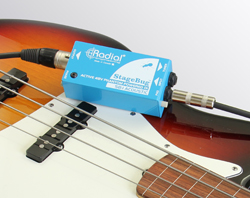
Using a microphone eliminates hum from ground loops which are often troublesome when using DI units with mains-powered amplifiers. But a microphone will of course pick up background noise which a DI connection will not, and will most often be more susceptible to feedback in live situations.
If an electric guitar is to be connected to a DI and an amplifier is to be connected as well, then the DI unit must have a pass-through connector. Alternatively take a signal from the amplifier, see below. For players using effects (including distortion) built in to their amplifiers, this is the only option, otherwise the contribution of these effects will be lost. If a pass-through is used, normally the DI unit is between any effects units and the amplifier for the same reason.
Suitable units:
Active
Passive balun type
Electric Bass Guitar/Acoustic Guitar. When dealing with electric bass or acoustic guitar, a DI is most often preferrable to using a microphone on an amplifier. This is because these instruments are often valued in a mix for being clean.
The signal path from the instrument should go into the DI unit and should then pass through to any sort of instrument amplifier. Often any amp used in this setup would be for monitoring purposes only, with the major component of the sound coming from the balanced send of the DI. The DI should be chosen with the specifications of the individual instrument in mind.
Often the best possible tone is achieved by one stage of preamplification. Following this idea, an active instrument, which means that the instrument has a preamplifier inside of it, should utilize a passive DI unit, while a passive instrument, meaning there is no preamplifier inside, should utilize an active DI.
Instrument Amplifiers. Some high-end instrument amplifiers contain built-in DI units. Most of these work as well as or better than any external unit, as they are well matched to the signal, but caution should be used with these as they often are not transformer isolated.
Better results will often (not always) be obtained by instead using a microphone in front of the loudspeaker. This is especially true of electric guitar. Using a microphone eliminates hum from ground loops which are often troublesome when using DI units with mains-powered amplifiers. But a microphone will of course pick up background noise which a DI connection will not, and will most often be more susceptible to feedback in live situations.
Suitable units:
Active
—From line or slave output
—From loudspeaker output (parallel to loudspeakers)
—From effects loop (may need pass-through)
Passive resistive load type
—From loudspeaker output (parallel to loudspeakers, and check impedance and power handling capacity of the DI!)
Passive balun type
—From line or slave output
Tips & Tricks
One of the most common applications for DI boxes is to connect equipment with high-impedance outputs (such as synths) to a mixer’s low-impedance inputs using long cables. If you were to run a long cable (say, 100 feet) from a guitar to an amp, it would completely load the guitar; you’d lose high-frequency response and add noise.
However, if you connect the guitar to a nearby DI box with a short instrument cable, you can then run a 100-foot mic cable to a mic preamp near the guitar amp. The mic preamp’s output is then connected to the input of the amp.
Ready to learn and laugh? Chris Huff writes about the world of church audio at Behind The Mixer. He covers everything from audio fundamentals to dealing with musicians, and can even tell you the signs the sound guy is having a mental breakdown. To view the original article and to make comments, go here.
